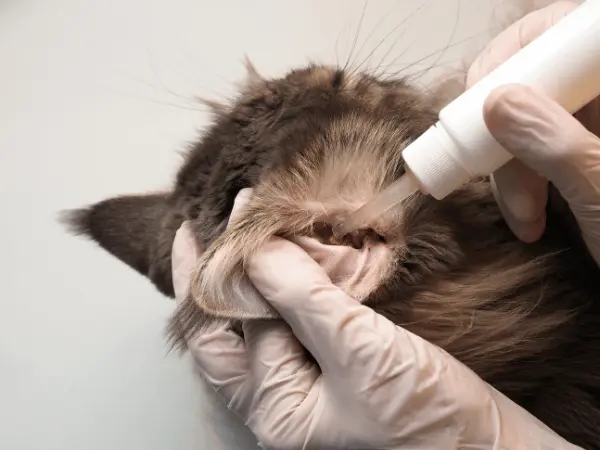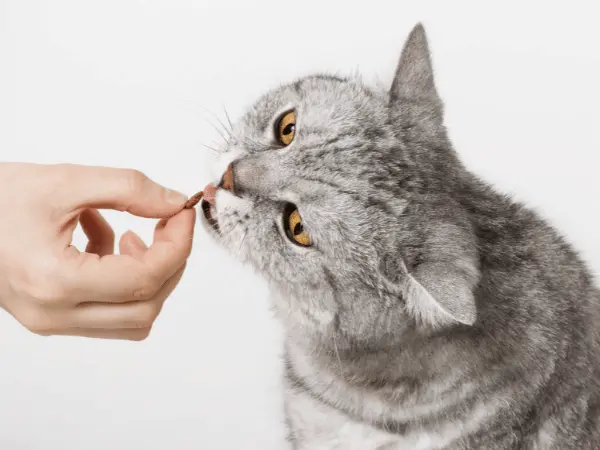At Sploot, our vets get asked questions about ear care for cats, such as “Do you need to clean a cat’s ears?”, “Should you clean the inside of your cat’s ears”, and so on.
Ear cleaning is necessary for cats in specific situations; it can help prevent the onset or progression of ear irritation or ear infections in cats. However, overcleaning or inappropriate cleaning can do more harm than good.
To help pet parents, we’ve put together this guide about how to clean a cat’s ears, the recommended times to do so, and what to use.
What’s In This Guide?
- Do You Need to Clean a Cat’s Ears?
- Should you Clean the Inside of Your Cat’s Ears?
- What is the Black Stuff in My Cat’s Ears?
- What to Clean a Cat’s Ears With
- How to Clean a Cat’s Ears [Step-By-Step]

Do You Need to Clean a Cat’s Ears?
Unlike dogs, most cats don’t require regular ear cleaning. However, certain situations may require regular ear cleaning. If any of the following describes your cat, make sure to consult your vet to determine the best frequency for at-home ear cleaning for your cat:
1. A Build-Up of Earwax
You may observe light brown ear wax on your cat’s ear; this is particularly common in Sphynx cats and brachycephalic breeds like Himalayan and Persian cats Cats may also produce more ear wax if they are experiencing food allergies and/or seasonal allergies (like spring allergies and fall allergies). In these cases, regular ear cleaning may be a part of your vet’s recommendations.
2. Ear Irritation & Ear Infection
Ear irritations can be due to debris, excess ear wax, or active ear infections (caused by yeast, bacteria, or ear mites).
In most cases, ear irritation manifests as excessive scratching, redness, head shaking, and head tilting. Meanwhile, ear infections are associated with the symptoms of ear irritation plus any of the following: discharge, black debris, and/or a bad odor coming from the ears.
Note: Avoid self-medicating if you suspect ear infection or irritation in your cat. Using antimicrobial ear cleansers and other products as a home remedy can do more harm than good. In case of misdiagnosis, pet parents may inadvertently strengthen the pathogen and cause the infection to worsen. Dr. Molly Wozniak, Sploot’s veterinarian, further explains: “Certain at-home remedies can cause more damage, especially if there is a ruptured ear drum. Always consult a vet so that the eardrum can be evaluated first”

Should you Clean the Inside of Your Cat’s Ears?
This depends on what your vet recommends based on your cat’s individual needs. Some cats can benefit from a regular wiping of their external ear flaps —while some may benefit from using cat ear cleansers that go into the ear canal.
When poured directly into the cat’s ear opening, cat ear cleaners reach up to the horizontal ear canal, just before the eardrum. This is still considered part of the cat’s external ear.
Note: Regular at-home ear cleaning should NOT go beyond the cat’s eardrum. The eardrum acts as a seal — unless it’s perforated due to ear infections. Perforated ear drums are contraindicated with certain cat ear cleaners, which further necessitates strict vet guidance during treatment.
What is the Black Stuff in My Cat’s Ears?
One of the most common questions we get at our vet clinics is “What is the black stuff in my cat’s ears?” Some pet parents look into ear cleaning for cats because of crumbly black debris that appears on their ear flaps. While often mistaken for dirt or dried-up earwax, this black substance is ear mite debris.
Note: If your cat has ear mite debris on their ears, get in touch with a vet. They will prescribe cat ear cleansers and/or medicated ear drops that will manage the ear mite infestation.
What to Clean a Cat’s Ears With
To clean your cat’s ears appropriately, you need the following:
- Clean cotton balls or cotton pads — use these to wipe the outer ear during cleaning. AVOID using cotton swabs or Q-tips, as they can push debris further into the ear canal. Q-tips can also rupture the cat’s eardrum.
- Ear cleaning solution — your veterinarian can recommend a suitable cat ear cleaner. AVOID products made for humans or other species. DO NOT USE alcohol, hydrogen peroxide, and other harsh chemicals.
- Ear wipes — these are wipes with a gentle ear-cleaning formula; they are useful for cleaning the external ear flaps.
These additional items may also help:
- Towel — certain cats (especially first-timers) may need to be held with a towel. If your cat seems resistant to having their ears touched, carefully swaddling your cat in a towel can help prevent cat scratches and sudden movements.
- Treats — help your cat form a positive association with ear cleaning by rewarding them with delicious cat treats.
Note: Searching for vet-approved cat ear cleaners and ear wipes? Learn more from our article: Best Cat Ear Cleaners & Ear Wash [How to Choose]
The Best Way To Clean a Cat’s Ears [Steps & Photos]
Once you’ve spoken to your vet and have all the necessary supplies, read through these steps on how to clean a cat’s ears. We encourage pet parents to know these by heart before getting started. A cat’s ears are sensitive — thus, cats are likely to resist or try to escape during ear cleaning. It is important to act swiftly and surely, not letting your cat wait too long in between steps. In any case, be firm but gentle as you follow these instructions:
1. Prepare Your Cat
Make sure that your cat is calm and relaxed. If your cat is resistant to having their ears touched, enlist the help of a friend or family member while ear cleaning. You can also you can use a towel to swaddle your cat securely on your lap— just ensure that the cat is upright (NOT belly up) while cleaning their ears.
2. Wipe Your Cat’s External Ear
Hold your cat’s ear and use a cotton ball, cotton pad, or an ear wipe for cats to clean their ear flap. This helps remove any trapped dirt or debris.
Note: If your vet only recommended ear wipes for your cat, you can stop here.

3. Use a Vet-Approved Cat Ear Cleaner
Gently pull back your cat’s earflap and administer the cat ear cleaning solution. Cat ear cleaners usually have special tips for easy administration. Do NOT push the nozzle inside the cat’s ear as this can push ear wax back.

4. Massage the Base of the Ear
Gently massage the base of your cat’s ear for about 20 to 30 seconds. This helps the solution break up any wax or debris.
Then, allow your cat to shake their ears as this helps flush the ear cleaner out, along with the particles it’s carrying.
5. Wipe The Ears
Use a cotton pad or cotton ball to wipe away any remaining debris and cleaning fluid from the cat’s outer ear.
6. Use Medicated Ear Drops [If Prescribed]
If your cat has an active ear infection, your vet may prescribe medicated ear drops. Ear cleaning helps prepare the cat’s ear so that medicated ear drops can be applied effectively. So, unless otherwise instructed, ear drops are generally administered right after ear cleaning.
Note: Make sure to follow your vet’s instructions and give them a call if you’re uncertain. Medicated ear drops are NOT part of routine ear cleaning for cats; they are to be used solely for treating ear infections.
7. Treats & Praise
After cleaning both ears and using medicated ear drops (if needed), reward your cat with treats and praise. This helps them form a positive association with ear cleaning, encouraging them to cooperate in future sessions.

Final Thoughts on How to Clean a Cat’s Ears
Vet-recommended ear cleaning is an important part of a cat’s care routine. As a final reminder, always consult a vet if you’re unsure or if you notice persistent issues with your cat’s ears. Regular pet wellness exams can also help catch and treat any ear problems before they become serious.
Sploot Vets: Your Fear Free Cat Vet in Denver & Chicago
Do you have questions on how to clean a cat’s ears and other aspects of feline health? Sploot Vets is always here to help. We are a Fear Free vet clinic in Denver & Chicago, offering primary, urgent, & emergency vet services under one roof.
Experience compassionate, next-level vet care in our modern vet clinics, complete with private exam rooms, state-of-the-art facilities, and FREE treats from the treat bar.
Book an appointment online or through the Sploot Vets app. We accept scheduled, same-day, and drop-off appointments. Till next time, we’re with you every pounce of the way!
